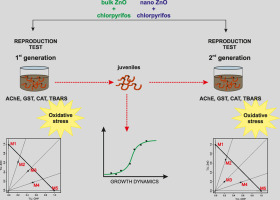当前位置:
X-MOL 学术
›
Chemosphere
›
论文详情
Our official English website, www.x-mol.net, welcomes your feedback! (Note: you will need to create a separate account there.)
Is nano ZnO/chlorpyrifos mixture more harmful to earthworms than bulk ZnO? A multigeneration approach.
Chemosphere ( IF 8.8 ) Pub Date : 2020-01-10 , DOI: 10.1016/j.chemosphere.2020.125885 Ž Lončarić 1 , D K Hackenberger 1 , I Jug 2 , B K Hackenberger 1
Chemosphere ( IF 8.8 ) Pub Date : 2020-01-10 , DOI: 10.1016/j.chemosphere.2020.125885 Ž Lončarić 1 , D K Hackenberger 1 , I Jug 2 , B K Hackenberger 1
Affiliation

|
As chlorpyrifos is one of the most widely used organophosphorus insecticides and ZnO-NPs are identified as NPs of the highest concern due to their negative effects on aquatic and soil organisms the objective of this study was to evaluate mixture toxicity of CHP and ZnO (bulk and nanoparticles (20 nm)) on two types of soil, artificial (AS) and natural (NS), and over two generations of earthworms. Primary endpoint measured was reproduction inhibition and biochemical biomarkers (acetylcholinesterase, catalase, glutathione-S transferase and malondialdehyde content). Results showed that mixture toxicity differs in respects to all tested factors: soil type, ZnO particle size and earthworm generation. CHP/ZnO mixtures had synergistic effects and significantly reduced a number of juveniles in both generations in AS, while the effects were additive or even antagonistic in NS. There was no difference in reproduction inhibition in respect to particle size of ZnO used in the mixtures. Negative effects could also be detected on growth dynamics of juvenile earthworms (2nd generation) as they had lower initial body mas, reduced growth rate and lower body mass as adults. Measured enzymes responded differently in respect to ZnO particle size used in the mixtures, with CHP/bZnO producing stronger effects. Measured concentrations of the bioavailable Zn in the soils showed no difference in the concentration of bioavailable Zn2+ between mixtures, but significantly more Zn2+ was retrieved from AS. General biomarker response indicated that 2nd generation of earthworms had lower capability to cope with oxidative stress.
中文翻译:

纳米ZnO /毒死rif混合物对bulk的危害大于散装ZnO吗?多代方法。
由于毒死rif是最广泛使用的有机磷杀虫剂之一,并且由于ZnO-NPs对水生生物和土壤生物具有负面影响,因此被确定为最受关注的NPs。本研究的目的是评估CHP和ZnO的混合物毒性(散装和纳米(20 nm))分布在两种类型的土壤上:人工(AS)和天然(NS),以及两代以上的worm。测量的主要终点是生殖抑制和生化生物标志物(乙酰胆碱酯酶,过氧化氢酶,谷胱甘肽-S转移酶和丙二醛含量)。结果表明,混合物毒性在所有测试因素方面均不同:土壤类型,ZnO粒径和worm的产生。CHP / ZnO混合物具有协同作用,并显着减少了AS中两个世代的少年数量,而这种作用在NS中是累加甚至拮抗的。关于混合物中使用的ZnO的粒径,繁殖抑制没有差异。由于幼虫的初始身体质量较低,成年后的生长速率降低且体重较低,因此它们还可以检测到对第二代)的生长动力学产生负面影响。对于混合物中使用的ZnO粒度,测得的酶反应不同,CHP / bZnO产生更强的作用。测得的土壤中可生物利用的Zn的浓度显示混合物之间可生物利用的Zn2 +的浓度没有差异,但是从AS中回收的Zn2 +明显更多。总体生物标志物响应表明,第二代worm应对氧化应激的能力较低。关于混合物中使用的ZnO的粒径,繁殖抑制没有差异。由于幼虫的初始身体质量较低,成年后的生长速率降低且体重较低,因此它们还可以检测到对第二代)的生长动力学产生负面影响。对于混合物中使用的ZnO粒度,测得的酶反应不同,CHP / bZnO产生更强的作用。测得的土壤中可生物利用的Zn的浓度显示混合物之间可生物利用的Zn2 +的浓度没有差异,但是从AS中回收的Zn2 +明显更多。总体生物标志物响应表明,第二代worm应对氧化应激的能力较低。就混合物中使用的ZnO的粒径而言,复制抑制没有差异。由于幼虫的初始身体质量较低,成年后的生长速率降低且体重较低,因此它们还可以检测到对第二代)的生长动力学产生负面影响。对于混合物中使用的ZnO粒度,测得的酶反应不同,CHP / bZnO产生更强的作用。测得的土壤中可生物利用的Zn的浓度显示混合物之间可生物利用的Zn2 +的浓度没有差异,但是从AS中回收的Zn2 +明显更多。总体生物标志物响应表明,第二代worm应对氧化应激的能力较低。由于幼虫的初始身体质量较低,成年后的生长速率降低且体重较低,因此它们还可以检测到对第二代)的生长动力学产生负面影响。对于混合物中使用的ZnO粒度,测得的酶反应不同,CHP / bZnO产生更强的作用。测得的土壤中可生物利用的Zn的浓度显示混合物之间可生物利用的Zn2 +的浓度没有差异,但是从AS中回收的Zn2 +明显更多。总体生物标志物响应表明,第二代worm应对氧化应激的能力较低。由于幼虫的初始身体质量较低,成年后的生长速率降低且体重较低,因此它们还可以检测到对第二代)的生长动力学产生负面影响。对于混合物中使用的ZnO粒度,测得的酶反应不同,CHP / bZnO产生更强的作用。测得的土壤中可生物利用的Zn的浓度显示混合物之间可生物利用的Zn2 +的浓度没有差异,但是从AS中回收的Zn2 +明显更多。总体生物标志物响应表明,第二代worm应对氧化应激的能力较低。对于混合物中使用的ZnO粒度,测得的酶反应不同,CHP / bZnO产生更强的作用。测得的土壤中可生物利用的Zn的浓度显示混合物之间可生物利用的Zn2 +的浓度没有差异,但是从AS中回收的Zn2 +明显更多。总体生物标志物响应表明,第二代worm应对氧化应激的能力较低。对于混合物中使用的ZnO粒度,测得的酶反应不同,CHP / bZnO产生更强的作用。测得的土壤中可生物利用的Zn的浓度显示混合物之间可生物利用的Zn2 +的浓度没有差异,但是从AS中回收的Zn2 +明显更多。生物标志物的一般反应表明,第二代of应对氧化应激的能力较低。
更新日期:2020-01-11
中文翻译:

纳米ZnO /毒死rif混合物对bulk的危害大于散装ZnO吗?多代方法。
由于毒死rif是最广泛使用的有机磷杀虫剂之一,并且由于ZnO-NPs对水生生物和土壤生物具有负面影响,因此被确定为最受关注的NPs。本研究的目的是评估CHP和ZnO的混合物毒性(散装和纳米(20 nm))分布在两种类型的土壤上:人工(AS)和天然(NS),以及两代以上的worm。测量的主要终点是生殖抑制和生化生物标志物(乙酰胆碱酯酶,过氧化氢酶,谷胱甘肽-S转移酶和丙二醛含量)。结果表明,混合物毒性在所有测试因素方面均不同:土壤类型,ZnO粒径和worm的产生。CHP / ZnO混合物具有协同作用,并显着减少了AS中两个世代的少年数量,而这种作用在NS中是累加甚至拮抗的。关于混合物中使用的ZnO的粒径,繁殖抑制没有差异。由于幼虫的初始身体质量较低,成年后的生长速率降低且体重较低,因此它们还可以检测到对第二代)的生长动力学产生负面影响。对于混合物中使用的ZnO粒度,测得的酶反应不同,CHP / bZnO产生更强的作用。测得的土壤中可生物利用的Zn的浓度显示混合物之间可生物利用的Zn2 +的浓度没有差异,但是从AS中回收的Zn2 +明显更多。总体生物标志物响应表明,第二代worm应对氧化应激的能力较低。关于混合物中使用的ZnO的粒径,繁殖抑制没有差异。由于幼虫的初始身体质量较低,成年后的生长速率降低且体重较低,因此它们还可以检测到对第二代)的生长动力学产生负面影响。对于混合物中使用的ZnO粒度,测得的酶反应不同,CHP / bZnO产生更强的作用。测得的土壤中可生物利用的Zn的浓度显示混合物之间可生物利用的Zn2 +的浓度没有差异,但是从AS中回收的Zn2 +明显更多。总体生物标志物响应表明,第二代worm应对氧化应激的能力较低。就混合物中使用的ZnO的粒径而言,复制抑制没有差异。由于幼虫的初始身体质量较低,成年后的生长速率降低且体重较低,因此它们还可以检测到对第二代)的生长动力学产生负面影响。对于混合物中使用的ZnO粒度,测得的酶反应不同,CHP / bZnO产生更强的作用。测得的土壤中可生物利用的Zn的浓度显示混合物之间可生物利用的Zn2 +的浓度没有差异,但是从AS中回收的Zn2 +明显更多。总体生物标志物响应表明,第二代worm应对氧化应激的能力较低。由于幼虫的初始身体质量较低,成年后的生长速率降低且体重较低,因此它们还可以检测到对第二代)的生长动力学产生负面影响。对于混合物中使用的ZnO粒度,测得的酶反应不同,CHP / bZnO产生更强的作用。测得的土壤中可生物利用的Zn的浓度显示混合物之间可生物利用的Zn2 +的浓度没有差异,但是从AS中回收的Zn2 +明显更多。总体生物标志物响应表明,第二代worm应对氧化应激的能力较低。由于幼虫的初始身体质量较低,成年后的生长速率降低且体重较低,因此它们还可以检测到对第二代)的生长动力学产生负面影响。对于混合物中使用的ZnO粒度,测得的酶反应不同,CHP / bZnO产生更强的作用。测得的土壤中可生物利用的Zn的浓度显示混合物之间可生物利用的Zn2 +的浓度没有差异,但是从AS中回收的Zn2 +明显更多。总体生物标志物响应表明,第二代worm应对氧化应激的能力较低。对于混合物中使用的ZnO粒度,测得的酶反应不同,CHP / bZnO产生更强的作用。测得的土壤中可生物利用的Zn的浓度显示混合物之间可生物利用的Zn2 +的浓度没有差异,但是从AS中回收的Zn2 +明显更多。总体生物标志物响应表明,第二代worm应对氧化应激的能力较低。对于混合物中使用的ZnO粒度,测得的酶反应不同,CHP / bZnO产生更强的作用。测得的土壤中可生物利用的Zn的浓度显示混合物之间可生物利用的Zn2 +的浓度没有差异,但是从AS中回收的Zn2 +明显更多。生物标志物的一般反应表明,第二代of应对氧化应激的能力较低。


























 京公网安备 11010802027423号
京公网安备 11010802027423号